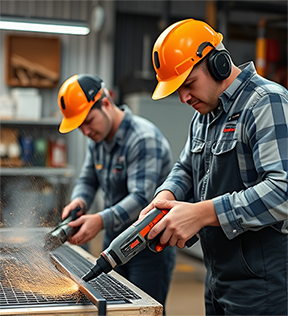Published: March 20, 2025 | Updated: October 21, 2025
Published: March 20, 2025 | Updated: October 21, 2025
How MRO Enhances Maintenance Efficiency and Business Success
 Maintenance department teams use a lot of terminology to define the various activities done in a company. This discussion focuses on Maintenance, Repair, and Operations (MRO). Read on to learn the following:
Maintenance department teams use a lot of terminology to define the various activities done in a company. This discussion focuses on Maintenance, Repair, and Operations (MRO). Read on to learn the following:
- Understanding MRO and Its Role in Maintenance Efficiency.
- How Facilities Utilize MRO to Improve Operations.
- Why MRO is Crucial for Maintenance Efficiency and Business Growth.
- The Role of MRO Across Industries.
- How CMMS Optimizes MRO for Better Maintenance Efficiency.
Understanding MRO and Its Role in Maintenance Efficiency
You might look at MRO as the inventory technicians use to keep assets running at a baseline functionality. Parts and supplies. The department uses these for general repairs and routine preventative maintenance (PM).
How Facilities Utilize MRO to Improve Operations
Essential Equipment and Machinery for MRO
Equipment / Machines: This category includes items essential for keeping machinery and production lines running smoothly. Examples include:
- Lubricants. Oils, greases, and other fluids used to reduce friction and wear in machinery.
- Belts and hoses. Essential for transmitting power and fluids within equipment.
- Valves and pumps. Control the flow of fluids and gases in various systems.
- Motors and gears. Replaceable components that drive machinery operation.
- Spare parts. Readily available replacements for commonly failing components, minimizing downtime.
Common Consumables and Supplies in MRO
Miscellaneous Supplies: These are items used up during daily operations and need regular replenishment. Examples include:
- Cleaning. Disinfectants, mops, brooms, and other materials for maintaining cleanliness.
- Office supplies. Paper, pens, toner cartridges, and other essential office materials.
- Safety equipment. Gloves, masks, safety glasses, hard hats, and other personal protective gear.
- Light bulbs. Replacements for lighting fixtures throughout facilities.
- Fasteners. Nuts, bolts, screws, and other hardware used in various applications.
Tools and Technology for Maintenance and Repairs
Tools: This category encompasses equipment used for maintenance and repair tasks. Examples include:
- Hand tools. Wrenches, screwdrivers, hammers, and other basic tools.
- Power tools. Drills, saws, grinders, and other equipment for heavier tasks.
- Measuring and testing equipment. Gauges, meters, and other tools for diagnostics and troubleshooting.
- Welding and soldering equipment. Used for joining metal components.
- PPE specific to maintenance tasks. Specific gloves, safety glasses, or respirators required for certain maintenance activities.
Technology and Hardware: This includes equipment used for communication, data processing, and other operational needs. Examples include:
- Computers and peripherals. Desktops, laptops, printers, scanners, etc.
- Networking equipment. Routers, switches, and cables for network connectivity.
- Software licenses. Essential software programs for various tasks.
- Communication devices. Phones, radios, and other equipment for communication within the facility.
Janitorial and Safety Supplies for Facility Maintenance
Janitorial Supplies: These are items used for maintaining a clean and hygienic environment. Examples include:
- Trash bags and liners. For waste disposal.
- Paper towels and toilet paper. Essential hygiene supplies.
- Cleaning chemicals. Disinfectants, soaps, and other cleaning agents.
- Mops, brooms, and other cleaning tools. Used for cleaning floors and surfaces.
Why MRO is Crucial for Maintenance Efficiency and Business Growth
Why does a company need MRO? How does it help overall company operations?
- Increased Efficiency and Productivity:
- Proper maintenance and repairs of equipment minimize downtime.
- Having readily available tools and consumables prevents delays and allows tasks to be completed efficiently.
- A clean and safe work environment fostered by MRO practices contributes to employee well-being and productivity.
- Reduced Costs:
- Proactive maintenance helps prevent costly equipment breakdowns and the associated repair expenses.
- Efficient inventory management of MRO items minimizes unnecessary overstocking and reduces storage costs.
- Optimized procurement practices can lead to better pricing and cost savings on MRO supplies.
- Improved Safety:
- Regular maintenance and safety checks of equipment and facilities minimize the risk of accidents and injuries.
- Having the proper safety equipment readily available protects employees and prevents potential hazards.
- A clean and well-maintained work environment reduces the risk of slips, falls, and other safety incidents.
- Enhanced Asset Lifespan:
- Proper maintenance practices extend the lifespan of equipment and facilities, reducing the need for frequent replacements.
- This translates to long-term cost savings and avoids disruptions caused by equipment failures.
- Overall Business Continuity:
- Efficiency helps sustainability and consistency. It enhances the company's reputation. This leads to greater reliability, customer satisfaction, and overall business success.
In essence, MRO acts as the backbone of smooth operations. It maintains the proper functioning of equipment, facilities, and supplies. This directly impacts efficiency, cost control, safety, and ultimately, the overall profitability of a company.
Discover how streamlined maintenance processes can elevate production. Learn more.
The Role of MRO Across Industries
- General Asset Repair and Maintenance: This focuses on the upkeep of critical machinery and systems directly involved in the production process. Examples include:
- Industrial machinery like pumps, motors, and conveyors.
- Robotics and automation equipment.
- Production line tools and instrumentation.
- Mobile Equipment: This encompasses the assets used to move and manage materials throughout the facility. Examples include:
- Forklifts and other lifting equipment.
- Conveyor systems and storage solutions.
- Trucks and other vehicles within the facility.
- Structural Assets: This deals with the upkeep of the physical structure and supporting systems of the facility itself.\ Examples include:
- Building repairs and maintenance (roof, walls, floors).
- HVAC systems and electrical infrastructure.
- Plumbing and sanitation systems.
- Landscaping and grounds maintenance.
- Operational Supplies: This includes the wide range of tools, supplies, and materials needed for various tasks within the facility. Examples:
- Hand tools and power tools.
- Cleaning supplies and safety equipment.
- Office supplies and stationery.
- Fasteners and lubricants.
 How CMMS Optimizes MRO for Better Maintenance Efficiency
How CMMS Optimizes MRO for Better Maintenance Efficiency
Many maintenance departments enjoy the organizational aspects of a CMMS. This software acts as a central database for assets, inventory, preventive maintenance, and work orders. Let's explore these benefits further:
- Improved Preventive Maintenance: CMMS allows for the creation and scheduling of preventive maintenance tasks based on equipment specifications and usage data. This proactive approach helps prevent equipment failures, minimizing downtime and associated costs. Reminders and alerts ensure the timely completion of preventive tasks, extending equipment lifespan.
- Enhanced Work Order Management: CMMS software streamlines the work order process. From work requests to creating orders. From detailed instructions to labor assignments. From completion to historical documentation. Technicians receive clear and detailed work orders with all necessary information. Real-time updates and status tracking improve communication and accountability.
- Optimized Inventory Management: CMMS tracks MRO inventory levels, including spare parts, consumables, and tools.
Automated reordering based on minimum stock levels prevents stockouts and delays. Data analysis helps identify overstocking and optimize inventory costs.
- Reduced Costs: By preventing equipment failures and optimizing maintenance practices, CMMS leads to significant cost savings. Improved inventory management reduces unnecessary purchases and overstocking. Insights from reports enable better resource allocation and cost control.
- Improved Data Analytics and Reporting: CMMS collects and stores data on maintenance activities, equipment performance, and inventory usage. Supervisors analyze this data to identify trends, predict potential problems, and make informed decisions.
Reports generated by the CMMS provide valuable insights for optimizing MRO processes.
Why Companies Should Prioritize MRO for Long-Term Success
Companies should not ignore MRO. For maintaining assets, you need inventory. This involves monitoring stock levels and proper purchasing processing. With so many assets to care for, supervisors need to oversee many aspects of MRO.
Using a CMMS can greatly benefit the entire operation. The software provides needed organization and shows areas for improvement.
For a superior CMMS, call MAPCON at 800-922-4336 for a free demonstration. You work hard. MAPCON helps you work smarter.
FAQs
What is MRO and why is it essential for maintenance efficiency?
MRO stands for Maintenance, Repair, and Operations, and it encompasses the inventory, parts, and supplies used by technicians to keep assets running at baseline functionality and reduce unplanned downtime.
What types of inventory fall under MRO in a facility?
MRO inventory includes essential categories such as lubricants and spare parts for equipment, consumables and supplies like cleaning materials, and various hand and power tools for repairs.
How does effective MRO management lead to business success?
Effective MRO management minimizes costly equipment breakdowns, extends the lifespan of assets, and contributes to a clean and safe environment, leading to increased productivity and business continuity.
How does CMMS software enhance MRO inventory management?
CMMS software optimizes MRO by tracking stock levels for spare parts and consumables, automating reordering based on minimum stock levels, and providing data to reduce unnecessary purchases.
Can a CMMS help track maintenance work for MRO items?
Yes, a CMMS, like the one from MAPCON, streamlines the work order process from request to completion, ensuring MRO inventory usage is tracked and maintenance tasks are executed with detailed instructions.
What role does MRO play across different industries?
MRO is crucial across industries for general asset repair (motors, conveyors), maintaining mobile equipment (forklifts, vehicles), and structural upkeep (HVAC, plumbing, and building repairs).
MAPCON CMMS software empowers you to plan and execute PM tasks flawlessly, thanks to its wealth of features and customizable options. Want to see it for yourself? Click the button below to get your FREE 30-day trial of MAPCON!
Try It FREE!